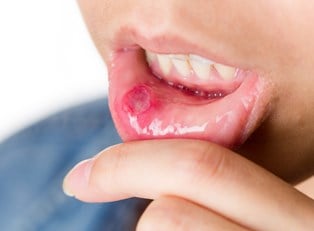Also known as aphthous ulcers, canker sores are small, raised lesions that occur inside the mouth on the cheeks, lips, gums, and tongue. These sores usually appear as round and open, with a white or yellowish coating and a red halo surrounding the edges.
Types of Canker Sores
Most canker sores are small—one-fourth of an inch to six millimeters in diameter—and shallow. However, sometimes the sore can be much larger and deeper in the skin. Depending on the type of canker sore, they will appear different, have different levels of pain, and may take longer to heal.
Most of the time, canker sores will appear by themselves, but sometimes they will occur in small clusters. Again, this will depend on the type of canker sore that is developing. The most common types are:
- Minor canker sores – This is the most common and painless type of canker sore. Minor canker sores are usually very small, appear alone, and will heal without any scarring within one to two weeks.
- Major canker sores – Less common than the minor canker sores, major canker sores are much larger and deeper as well—which means they will likely be more painful. Because of their size, they also may take up to six weeks to completely heal, and scarring is probable.
- Herpetiform canker sores – This is the least common type of canker sore, and though these are smaller in size than even the minor canker sores, they will usually occur in clusters of around 10 up to 100 sores. If there are too many, they may even merge into one giant ulcer. However, herpetiform canker sores will usually heal in about a week and will typically not leave any scarring.
Diagnosis and Treatment
It is common to experience tingling or burning a few days before a canker sore is fully visible, but no other symptoms are usually apparent. If other symptoms are present, such as swollen lymph nodes or a fever, this could be a sign of an underlying condition that should be examined by a medical professional.
Since the typical healing time for most canker sores is within two weeks, if the pain or swelling lasts longer than this, you should consider seeing the doctor. Also, if you have unusually large sores or new sores that are developing before the old ones are able to heal, this can also be cause for concern.
Most canker sores will completely heal about two weeks after they first appear, but the worst of the pain will be confined to the first three days or so. During this time, over-the-counter pain relievers such as acetaminophen or ibuprofen can be used to help reduce the swelling. There are also other over-the-counter topical medications that can reduce the pain as well as the healing time if they are applied soon enough. A doctor might prescribe a mouth rinse or other topical medication for the same purposes, unless he or she finds a reason to be concerned about either the severity of the sore or other symptoms that are not normally associated with canker sores.



